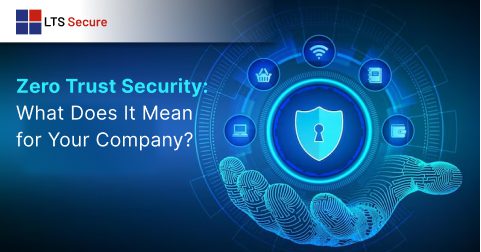Zero Trust Security: How Can It Help for Your Company?
Zero Trust Security: What Does It Mean for Your Company?
What is Zero Trust Security?
Zero Trust Security model helps organizations enforce policies and processes for authentication, authorization, and ongoing verification of all users and devices. It is based on the philosophy that no user, instrument, or application on the network should be trusted, even within the organization’s security perimeter.
To implement adaptive authentication, organizations typically use tools such as multi-factor authentication, granular access control, and endpoint security systems. Ideally, implementing Zero Trust should help organizations protect their networks from advanced threats and improve compliance with standards such as GDPR, FISMA, PCI, HIPAA, and CCPA.

Components of the Zero Trust Architecture
Zero Trust is a comprehensive security model that can protect an entire organization. At the heart of this model is data security. Data is a valuable asset to an attacker – it can include personally identifiable data (PII), protected health information (PHI), payment card information (PCI), or intellectual property (IP).
In addition to protecting data, Zero Trust Security provides controls to protect networks, workloads, and devices.
Zero Trust Data as Security Model
A Zero Trust approach requires first securing the data where it is stored and then adding additional layers of security and it is equally important.
Access to valuable data must be strictly limited, assuming attackers can breach security parameters, exploit misconfigured controls, or compromise internal accounts. Rules should be in place to detect and respond to abnormal data access before a breach occurs.
Zero Trust Network
Under Zero Trust, an attacker assume to have access to the network. Networks designed with a zero-trust approach use technologies such as next-generation firewalls (NGFW) to segment, isolate, and restrict network access, making it as difficult for attackers to access data as possible. Sensitive or critical systems.
Zero Trust Devices
With the advent of the Internet of Things, many devices can access enterprise systems, including smartphones, sensors, intelligent building systems, connected cars, and smart consumer devices. Each connected device represents an access point that an attacker can use to break into the network.
Is there a need for Zero Trust?
Next, Security in legacy systems you can define as protecting organizational resources from external threats. Legacy systems use VPNs or Firewalls to create a perimeter around an organization’s network. All users/devices on the organization’s network you can consider trusted users/devices and have unlimited access to all company resources.
What is Zero Trust Assessment?
Moreover, The Zero Trust Assessment provides a set of concepts and ideas designed to reduce the uncertainty associated with making accurate, least privileged on-demand access decisions in information systems and services in the face of perceived networks as a compromise.
How to implement zero trust security
Unlike traditional security approaches, zero trust is a significant change for many organizations. Here are three ways to implement a zero-trust model in your organization.
Evaluate and improve security tools.
Often, traditional network security tools do not fit the zero-trust architecture model.
Evaluate your security tools and identify tools or technologies that can add another layer of protection where you identify gaps. Fortunately, modern security devices you can interconnect and can share information to cover each other’s vulnerabilities.
Examples of commonly used tools to meet the requirements of a zero-trust framework include:
- Micro-segmentation network
- Single Sign-on (SSO) for all apps and data
- Multifactorial Recognition (MFA)
Besides,Advanced threat protection tools such as endpoint protection platform (EPP), endpoint detection and response (EDR), and extended detection and response (XDR).
Conclusion –
Finally, A trustless security framework you think need to require all users (inside or outside the organization’s network) to be authenticated, authorized and regularly checked against previous configurations and states. Grant access or retain software and data.
For more details zero trust model click https://en.wikipedia.org/wiki/Zero_trust_security_model.
Zero Trust is a security framework that requires users to be securely configured, authenticated, authorized, and authenticated before granting or storing access to all users, applications, and data, whether inside or outside the organization’s network.
Zero Trust is a framework for protecting infrastructure and data for today’s digital transformation. It covers the modern challenges facing businesses today, including remote workers, hybrid cloud environments, and payment software threats.